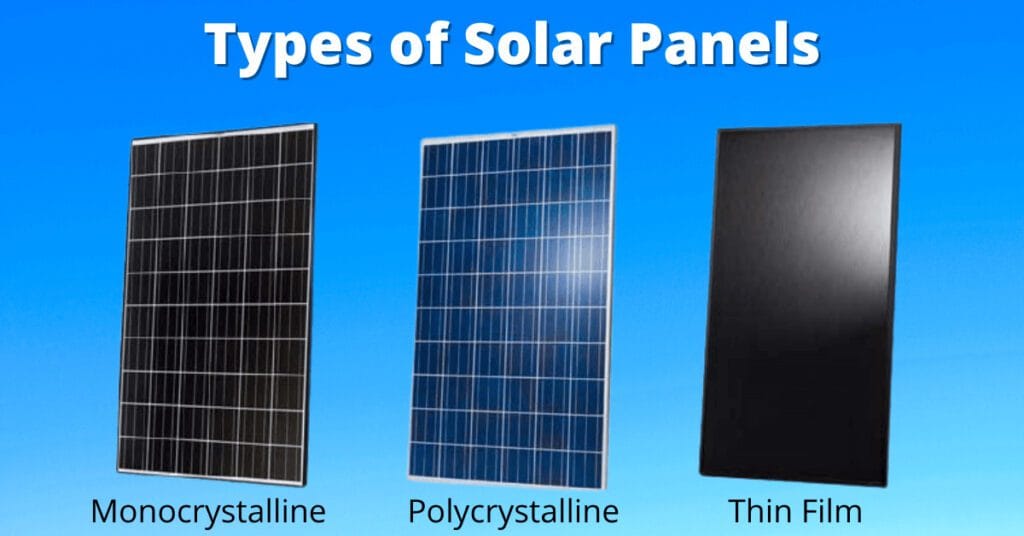Solar panels are at the forefront of renewable energy technology, converting sunlight into usable electricity. As the demand for sustainable energy solutions grows, understanding the types of solar panels and how they work becomes increasingly important. This comprehensive guide explores the various types of solar panels, their features, and their working mechanisms to help you make informed decisions when investing in solar energy.

What Are Solar Panels?
Solar panels, also known as photovoltaic (PV) panels, are devices that convert sunlight into electrical energy through the photovoltaic effect. They consist of multiple solar cells made from semiconductor materials, typically silicon. These cells absorb sunlight and generate direct current (DC) electricity, which can then be converted into alternating current (AC) for household or commercial use.
Types of Solar Panels
There are three primary types of solar panels available today, each with its unique characteristics, advantages, and limitations:
1. Monocrystalline Solar Panels
Features:
- Made from a single, pure crystal structure of silicon.
- Recognizable by their uniform, dark black appearance.
- Known for their high efficiency and durability.
How They Work: Monocrystalline panels are highly efficient due to their pure silicon structure, which allows electrons to move more freely, enhancing energy conversion. These panels perform well in both low-light and high-temperature conditions.
Advantages:
- Highest efficiency rates (15% – 22%).
- Long lifespan (up to 25 years or more).
- Space-efficient due to higher energy output per square foot.
Disadvantages:
- More expensive compared to other types.
- Manufacturing process generates more waste.
Applications: Ideal for residential rooftops and areas with limited installation space.
2. Polycrystalline Solar Panels
Features:
- Made from multiple silicon crystals melted together.
- Identified by their bluish hue and speckled texture.
- Slightly lower efficiency than monocrystalline panels.
How They Work: Polycrystalline panels utilize silicon fragments, which result in a less efficient electron flow compared to monocrystalline panels. However, they still effectively convert sunlight into electricity.
Advantages:
- More affordable than monocrystalline panels.
- Environmentally friendly manufacturing process with less waste.
- Good performance in sunny conditions.
Disadvantages:
- Lower efficiency rates (13% – 18%).
- Larger space required for the same energy output.
Applications: Suitable for large installations where space is not a constraint, such as farms and industrial sites.
3. Thin-Film Solar Panels
Features:
- Made by depositing thin layers of photovoltaic material (such as cadmium telluride, amorphous silicon, or copper indium gallium selenide) onto a substrate.
- Lightweight and flexible.
- Available in black or dark blue colors.
How They Work: Thin-film panels use less silicon, relying on alternative materials to capture sunlight. Their flexibility makes them suitable for unique applications.
Advantages:
- Lightweight and easy to install.
- Low production costs.
- Aesthetic and adaptable to various surfaces.
Disadvantages:
- Lower efficiency rates (7% – 13%).
- Shorter lifespan and durability.
- Requires more space for large energy outputs.
Applications: Ideal for portable solar setups, vehicles, and buildings with unconventional roof designs.
How Do Solar Panels Work?
The working mechanism of solar panels revolves around the photovoltaic effect, discovered in 1839 by Alexandre Edmond Becquerel. Here’s a step-by-step explanation of the process:
1. Absorption of Sunlight
Solar cells within the panel absorb sunlight, causing electrons in the silicon atoms to become energized.
2. Generation of Direct Current (DC)
The energized electrons create an electric current as they move through the cell.
3. Conversion to Alternating Current (AC)
An inverter converts the DC electricity into AC electricity, which is compatible with household appliances.
4. Energy Usage or Storage
The generated electricity can either power appliances directly or be stored in batteries for later use.
Comparing the Three Types of Solar Panels
Feature |
Monocrystalline |
Polycrystalline |
Thin-Film |
|---|---|---|---|
Efficiency |
High (15% – 22%) |
Moderate (13% – 18%) |
Low (7% – 13%) |
Cost |
Expensive |
Affordable |
Cheapest |
Lifespan |
25+ years |
20-25 years |
10-20 years |
Space Efficiency |
Excellent |
Good |
Poor |
Durability |
High |
Moderate |
Low |
Aesthetic Appeal |
Sleek and uniform |
Bluish and speckled |
Flexible and modern |
Choosing the Right Solar Panel for Your Needs
When selecting a solar panel type, consider the following factors:
- Budget: If cost is a primary concern, polycrystalline or thin-film panels may be suitable options.
- Space Availability: Monocrystalline panels are ideal for limited spaces due to their high efficiency.
- Durability Needs: For long-term investments, monocrystalline panels offer the best lifespan and performance.
- Application: Thin-film panels are perfect for portable setups and unconventional surfaces.
- Aesthetic Preferences: Choose a panel type that complements your building’s design.
Future of Solar Panel Technology
Advancements in solar technology aim to enhance efficiency, reduce costs, and broaden applications. Emerging technologies include:
- Bifacial Solar Panels: Capture sunlight from both sides for increased energy generation.
- Perovskite Solar Cells: Offer high efficiency and easier manufacturing processes.
- Building-Integrated Photovoltaics (BIPV): Panels integrated into building materials like windows and roofs.
- Floating Solar Farms: Panels installed on water bodies to save land and improve cooling.
Understanding the types of solar panels and how they work is crucial for making informed decisions about renewable energy solutions. Each type of solar panel—monocrystalline, polycrystalline, and thin-film—has its unique advantages and applications. By assessing your energy needs, budget, and installation conditions, you can choose the most suitable option to harness the power of the sun efficiently.
Solar energy is not just a step toward sustainability; it’s an investment in a cleaner, brighter future. Whether for residential, commercial, or portable applications, solar panels offer a reliable and eco-friendly solution to meet growing energy demands.
